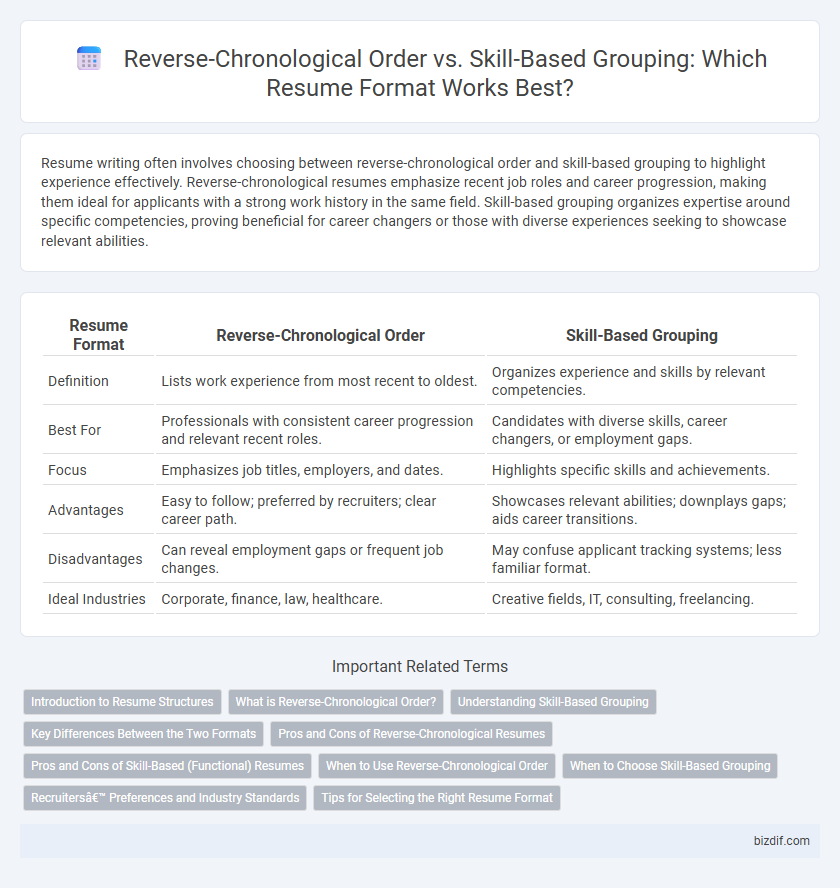Resume writing often involves choosing between reverse-chronological order and skill-based grouping to highlight experience effectively. Reverse-chronological resumes emphasize recent job roles and career progression, making them ideal for applicants with a strong work history in the same field. Skill-based grouping organizes expertise around specific competencies, proving beneficial for career changers or those with diverse experiences seeking to showcase relevant abilities.
Table of Comparison
| Resume Format | Reverse-Chronological Order | Skill-Based Grouping |
|---|---|---|
| Definition | Lists work experience from most recent to oldest. | Organizes experience and skills by relevant competencies. |
| Best For | Professionals with consistent career progression and relevant recent roles. | Candidates with diverse skills, career changers, or employment gaps. |
| Focus | Emphasizes job titles, employers, and dates. | Highlights specific skills and achievements. |
| Advantages | Easy to follow; preferred by recruiters; clear career path. | Showcases relevant abilities; downplays gaps; aids career transitions. |
| Disadvantages | Can reveal employment gaps or frequent job changes. | May confuse applicant tracking systems; less familiar format. |
| Ideal Industries | Corporate, finance, law, healthcare. | Creative fields, IT, consulting, freelancing. |
Introduction to Resume Structures
Reverse-chronological order highlights work experience by listing jobs from most recent to oldest, emphasizing career progression and stability. Skill-based grouping organizes achievements and competencies by relevant abilities, ideal for career changers or those with diverse experiences. Choosing the right resume structure depends on showcasing strengths effectively to align with job requirements.
What is Reverse-Chronological Order?
Reverse-chronological order is a resume format that lists work experience starting from the most recent position and moving backward in time. This format highlights a candidate's career progression and is preferred by most employers for clearly showcasing job history and dates. It emphasizes continuous employment and relevant experience, making it ideal for professionals with a strong, linear career path.
Understanding Skill-Based Grouping
Skill-based grouping organizes a resume by categorizing experiences and accomplishments under specific skill sets, highlighting competencies relevant to the job. This format emphasizes transferable skills and is ideal for career changers or professionals with diverse experience. Strategic use of skill-based grouping enhances applicant tracking system (ATS) compatibility by aligning keywords with job descriptions.
Key Differences Between the Two Formats
Reverse-chronological order lists work experience starting with the most recent position, highlighting career progression and stability, which appeals to employers seeking a clear job history. Skill-based grouping organizes information by relevant abilities and competencies rather than dates, making it ideal for career changers or those with gaps in employment. The key difference lies in reverse-chronological emphasizing timeline and job titles, while skill-based prioritizes transferable skills and expertise.
Pros and Cons of Reverse-Chronological Resumes
Reverse-chronological resumes highlight recent work experience, making it easier for employers to track career progression and evaluate job stability. This format is ideal for candidates with a strong, continuous work history but may expose employment gaps or frequent job changes. It lacks emphasis on specific skills, which can disadvantage applicants transitioning to new industries or roles.
Pros and Cons of Skill-Based (Functional) Resumes
Skill-based (functional) resumes highlight transferable skills and relevant experiences by organizing content around competencies rather than job history, making them ideal for career changers or gaps in employment. However, this format can obscure chronological work progression, potentially raising concerns for employers seeking clear employment timelines or recent experience. While emphasizing abilities can strengthen candidacies for skills-focused roles, it may reduce perceived transparency compared to reverse-chronological resumes favored by many recruiters.
When to Use Reverse-Chronological Order
Reverse-chronological order is ideal for candidates with a consistent work history and clear career progression, highlighting recent and relevant job experiences to attract recruiters quickly. This format is preferred in traditional industries like finance, law, and administration, where recent roles showcase career development and stability. Emphasizing job titles, employers, and dates helps hiring managers easily assess professional growth and qualifications.
When to Choose Skill-Based Grouping
Skill-based grouping resumes are ideal for candidates with diverse experiences or those transitioning between industries, as they emphasize relevant skills over job titles or dates. This format highlights competencies and achievements that directly align with the targeted role, making it easier for employers to see qualifications. Choose skill-based grouping when your career path is non-linear, or when specific skills outweigh chronological work history in showcasing your fit for the position.
Recruiters’ Preferences and Industry Standards
Recruiters predominantly prefer reverse-chronological order due to its clear presentation of career progression, making it easier to verify employment history and tenure. However, skill-based grouping, often referred to as a functional resume, is favored in industries like IT and creative fields where specific expertise and project accomplishments take precedence over linear job titles. Industry standards typically favor reverse-chronological formats in traditional sectors such as finance and law, while skill-based grouping gains traction in startups and consulting roles where adaptability and skill sets are critical.
Tips for Selecting the Right Resume Format
Choosing the right resume format depends on your work history and career goals. Use reverse-chronological order to highlight a steady work history and recent roles, which appeals to employers seeking clear career progression. Opt for skill-based grouping when emphasizing relevant skills over job titles, ideal for career changers or those with gaps in employment.
Reverse-chronological order vs Skill-based grouping Infographic

 bizdif.com
bizdif.com